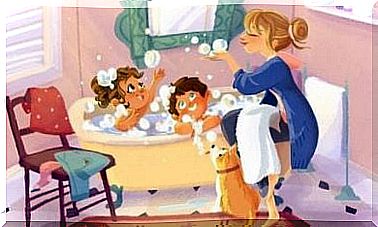Teen Self-mutilation: What You Need To Know

If you notice that your child has cuts, bruises, burns or frequent wounds, it is extremely important to pay attention. Teen self-mutilation is a silent way of screaming for help.
Technically, this behavior is known as non-suicidal self-mutilation. Until recently, the Diagnostic and Statistical Manual of Mental Disorders regarded this behavior as a symptom of some type of mental disorder.
Today, self-mutilating behavior is now treated as separate from mental illness. Teen self-mutilation is a problem that is growing at an alarming rate. Over the past 30 years, the number of cases of self-mutilation has increased worldwide.
The age of onset of self-mutilation in teens is between 12 and 16 years of age. At the same time, it appears that up to 63% of these teens continue to injure themselves until the age of 17. This clearly shows that a large number of young people are caught by this behavior.
Girls usually opt for injuries where they can see blood, such as scratches and cuts. However, guys usually target bruises and burns. The strange thing is, while women are more prone to this kind of behavior, the percentage among boys is growing much faster.
22% of European adolescents have injured themselves at least once in their lives without the intention of suicide. This is according to a study by the Department of Clinical Psychology and Health of the University of Madrid. In addition, the researchers concluded that 8% would injure themselves repeatedly.
Teen Self-Mutilation: Why Do They Do It?

To be clear, we could say that self-mutilation is like a drug. It is a type of pain reliever that is stronger than any other product on the market. Self-mutilation ‘helps’ teens regulate their emotions.
Sometimes fear, anger, sadness and anger appear repeatedly and teens don’t know how to deal with them. They therefore prefer physical pain and forget the emotional pain. It is a type of avoidant behavior that releases tension and reduces negative feelings.
It is important to point out that these actions are not impulsive in any way. Just the opposite. Teens plan them, waiting to be alone and enjoying their little ritual of knives, cigarettes, lighters and sharp objects.
As with other addictions, young people experience a false sense of calm immediately after they injure themselves. It’s like taking a dose of fast-acting drugs. The problem comes when, minutes later, the fear returns, along with feelings of shame and guilt.
While it’s true that these teens don’t try to kill themselves, self-mutilation does increase the chances of possible suicide attempts in the future. Parental intervention is extremely necessary when it comes to self-mutilation in teens.
Is there a solution?
Teen self-mutilation is a condition that absolutely requires psychological treatment. Teens need to understand that self-mutilation does nothing to solve their problems. Rather, it adds more problems to their lives.
It is important for professionals and parents to get to the root of the problem, in other words, what is causing a child’s depression, anxiety, eating disorder, etc.
Many therapists focus their efforts on emotional self-control teaching techniques. These may include the following:
- Intense exercise.
- Cold water showers.
- Make children scream.
- To slap pillows.
- etc.
Organizations such as the Self-harm Foundation offer help and orientation. They do this through therapy, counseling and resources, both for patients and their families.
It is important to understand that self-mutilation in teens is a strong cry for attention. Asking them why they do it will only make them more anxious. What these teens need is understanding and empathy.
A trend with many followers

Self-sabotage has become a trend with its own name: cutting. You can even find tips on how to do this online.
On Instagram, photos and videos of teens proudly showing off their injuries are available to everyone, without filters.
Many teens start hurting themselves for fun. What they want is a little more adrenaline, or to take on a challenge to post a viral hashtag on their timeline.
However, we should never minimize any sign of alarm. In most cases, self-injury is not an indication of a personality disorder. However, it is a sign of a:
- Low self esteem.
- Inability to have healthy relationships.
- Low emotional intelligence.
The consequences of self-injury during adolescence have been so important that a new television program, Sharp Objects, is openly addressing this issue. These kinds of tools, as well as professional intervention, can help you guide your child and find a solution.









